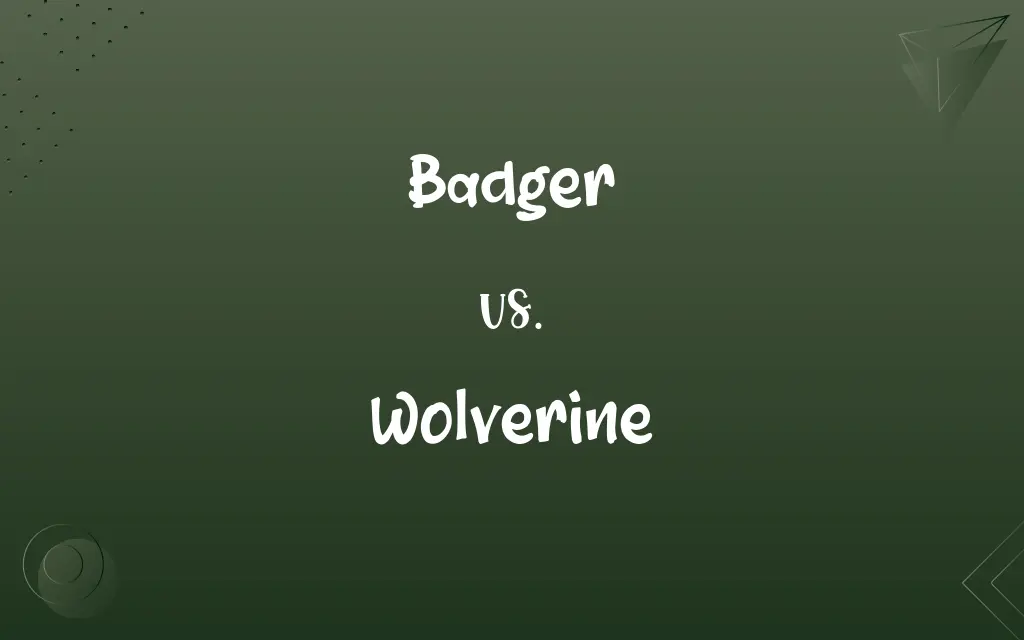Badger vs. Wolverine: Know the Difference

By Shumaila Saeed || Published on January 4, 2024
Badgers are medium-sized, burrowing mammals known for their striped faces, while wolverines are larger, stockier members of the weasel family, known for their strength and solitary nature.

Key Differences
Badgers are characterized by their short legs, elongated bodies, and distinctive facial stripes. They are medium-sized and vary in size and color based on species. Wolverines, in contrast, are larger and more robust, with a reputation for being exceptionally strong for their size. They have a stocky build and a bear-like appearance.
Shumaila Saeed
Jan 04, 2024
Badgers are found in various habitats including woodlands, grasslands, and urban areas, across different continents such as Europe, Asia, and North America. Wolverines are primarily found in remote areas of the northern boreal forests and subarctic and alpine tundra of the Northern Hemisphere, including parts of North America, Europe, and Asia.
Shumaila Saeed
Jan 04, 2024
Badgers are known for their digging abilities and live in extensive burrow systems called setts. They can be solitary or live in small family groups. Wolverines, on the other hand, are solitary animals, known for their fierce and territorial nature. They are opportunistic feeders and capable hunters.
Shumaila Saeed
Jan 04, 2024
The diet of badgers varies but typically includes earthworms, insects, small mammals, and occasionally fruits and plants. Wolverines have a more carnivorous diet, feeding on a variety of foods ranging from small to large mammals and are known to scavenge.
Shumaila Saeed
Jan 04, 2024
Many badger species are protected due to habitat loss and hunting. They often interact with human habitats, leading to conflict. Wolverines are elusive and less commonly seen by humans, but they face threats from habitat destruction and are considered a species of concern in some regions.
Shumaila Saeed
Jan 04, 2024
ADVERTISEMENT
Comparison Chart
Behavior
Solitary or small groups, excellent diggers
Solitary, territorial, strong hunters
Shumaila Saeed
Jan 04, 2024
Conservation Status
Many species protected, habitat interaction
Elusive, facing habitat destruction
Shumaila Saeed
Jan 04, 2024
ADVERTISEMENT
Badger and Wolverine Definitions
Badger
Badger’s adaptive nature
A badger adapted well to the urban environment.
Shumaila Saeed
Dec 19, 2023
Wolverine
Wolverine as a strong mammal
The wolverine is known for its incredible strength.
Shumaila Saeed
Dec 19, 2023
Wolverine
Wolverine’s solitary nature
A solitary wolverine roamed the vast tundra.
Shumaila Saeed
Dec 19, 2023
Badger
Badger’s interaction with humans
A badger sett was found near the hiking trail.
Shumaila Saeed
Dec 19, 2023
ADVERTISEMENT
Wolverine
Wolverine as a hunter
The wolverine hunted down a large prey with ease.
Shumaila Saeed
Dec 19, 2023
Wolverine
Wolverine in cold climates
Wolverines thrive in the snowy northern forests.
Shumaila Saeed
Dec 19, 2023
Wolverine
Wolverine in conservation
Conservation efforts are vital for the wolverine’s survival.
Shumaila Saeed
Dec 19, 2023
Badger
Any of several carnivorous burrowing mammals of the family Mustelidae, such as Meles meles of Eurasia or Taxidea taxus of North America, having short legs, long claws on the front feet, and a heavy grizzled coat.
Shumaila Saeed
Dec 13, 2023
Wolverine
A solitary mustelid mammal (Gulo gulo) of northern regions, having a heavyset body, short legs, dark fur, and a bushy tail, and known for its aggressive predatory behavior. Also called carcajou, glutton, skunk bear.
Shumaila Saeed
Dec 13, 2023
Badger
To ask or nag (someone) about something in an annoying and persistent way; pester
Badgered the boy into cleaning his room.
Shumaila Saeed
Dec 13, 2023
Badger
Any mammal of three subfamilies, which belong to the family Mustelidae: Melinae (Eurasian badgers), Mellivorinae (ratel or honey badger), and Taxideinae (American badger).
Shumaila Saeed
Dec 13, 2023
Badger
A crew of desperate villains who robbed near rivers, into which they threw the bodies of those they murdered.
Shumaila Saeed
Dec 13, 2023
Badger
(obsolete) An itinerant licensed dealer in commodities used for food; a hawker; a huckster; -- formerly applied especially to one who bought grain in one place and sold it in another.
Shumaila Saeed
Dec 13, 2023
Badger
To pester; to annoy persistently; to press.
He kept badgering her about her bad habits.
Shumaila Saeed
Dec 13, 2023
Badger
An itinerant licensed dealer in commodities used for food; a hawker; a huckster; - formerly applied especially to one who bought grain in one place and sold it in another.
Shumaila Saeed
Dec 13, 2023
Badger
A carnivorous quadruped of the genus Meles or of an allied genus. It is a burrowing animal, with short, thick legs, and long claws on the fore feet. One species (Meles meles or Meles vulgaris), called also brock, inhabits the north of Europe and Asia; another species (Taxidea taxus or Taxidea Americana or Taxidea Labradorica) inhabits the northern parts of North America. See Teledu.
Shumaila Saeed
Dec 13, 2023
Badger
To tease or annoy, as a badger when baited; to worry or irritate persistently.
Shumaila Saeed
Dec 13, 2023
Badger
Sturdy carnivorous burrowing mammal with strong claws widely distributed in the northern hemisphere
Shumaila Saeed
Dec 13, 2023
Badger
Annoy persistently;
The children teased the boy because of his stammer
Shumaila Saeed
Dec 13, 2023
Repeatedly Asked Queries
What is a wolverine?
A wolverine is a large, robust mammal belonging to the weasel family.
Shumaila Saeed
Jan 04, 2024
What is the diet of a wolverine?
Wolverines are carnivorous, eating small to large mammals.
Shumaila Saeed
Jan 04, 2024
Where do badgers live?
Badgers live in various habitats including woodlands, grasslands, and urban areas.
Shumaila Saeed
Jan 04, 2024
Are Badgers known for their digging abilities?
Yes, Badgers are skilled diggers and create extensive underground burrows.
Shumaila Saeed
Jan 04, 2024
What is a badger?
A badger is a medium-sized, burrowing mammal with distinctive facial markings.
Shumaila Saeed
Jan 04, 2024
Where are wolverines found?
Wolverines are found in northern boreal forests and subarctic tundra.
Shumaila Saeed
Jan 04, 2024
Are Wolverines solitary animals?
Yes, Wolverines are typically solitary and territorial creatures.
Shumaila Saeed
Jan 04, 2024
What do badgers eat?
Badgers mainly eat earthworms, insects, and small mammals.
Shumaila Saeed
Jan 04, 2024
Do Badgers have any natural predators?
Predators of Badgers can include larger carnivores like wolves and cougars.
Shumaila Saeed
Jan 04, 2024
Do Wolverines have cultural significance in any societies?
Wolverines are seen as symbols of strength and tenacity in some indigenous cultures, like the Inuit of North America.
Shumaila Saeed
Jan 04, 2024
Are badgers solitary animals?
Badgers can be solitary or live in small family groups.
Shumaila Saeed
Jan 04, 2024
Is the wolverine a solitary animal?
Yes, wolverines are known for their solitary and territorial nature.
Shumaila Saeed
Jan 04, 2024
Do Wolverines hibernate?
No, Wolverines do not hibernate and remain active year-round.
Shumaila Saeed
Jan 04, 2024
What is the significance of the badger in various cultures?
Badgers hold cultural significance in some indigenous societies, often representing attributes like tenacity and courage.
Shumaila Saeed
Jan 04, 2024
Are Badgers related to other animals like skunks and otters?
Yes, Badgers are part of the Mustelidae family, which also includes skunks, otters, and weasels.
Shumaila Saeed
Jan 04, 2024
Do Wolverines have any natural predators?
Wolverines have few natural predators, but larger carnivores like bears and wolves may pose a threat.
Shumaila Saeed
Jan 04, 2024
What are the threats to Wolverine populations?
Habitat loss and trapping are significant threats to Wolverine populations.
Shumaila Saeed
Jan 04, 2024
Share this page
Link for your blog / website
HTML
Link to share via messenger
About Author
Written by
Shumaila SaeedShumaila Saeed, an expert content creator with 6 years of experience, specializes in distilling complex topics into easily digestible comparisons, shining a light on the nuances that both inform and educate readers with clarity and accuracy.








































































